

I’m not saying the only consolation of driving 14+ hours to my hometown of Wichita and spending the entire week in 100+ degree weather is the food along the way. No, wait, I pretty much am saying that, at least since we exhausted the list (two items long) of tourist attractions I wanted to see last year. We managed to find another excellent one this year, or rather my sister-in-law did. But otherwise, family aside, the only thing to do was eat.
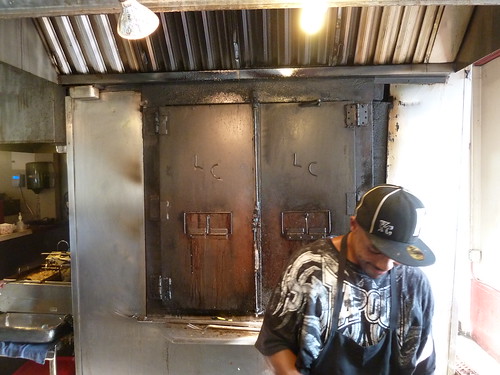
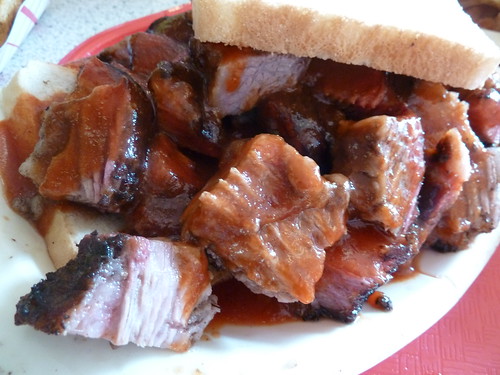
I wanted to visit L.C.’s BBQ in Kansas City again for dinner; there’s always a danger with barbecue of being wowed by one, irreproducible experience. As it turned out, it wasn’t as good as last year, but in ways that paradoxically confirmed its superiority. Huh? What am I smoking? Well, the thing with barbecue is, it’s always variable. And this year compared to last, the variation was that the burnt ends, luscious little meat and smoke nuggets, weren’t as done as last year, and hence were a little fatty and chewy. But you could tell what they’d be in another hour or two— and meanwhile the ribs, which hadn’t stood out last year, were terrific. A second visit, even though not perfect, convinced me that L.C.’s remains in the front rank of pit barbecue joints, and in contrast to so many new Kansas City places popping up, is still gritty and real enough to treat my kids to a real-life episode of Cops as we pulled up.
My original goal upon reaching Wichita the next morning was to eat at an old favorite, Takhoma Burger, which had apparently reopened in a former Tiki Dancing bar just south of downtown on the somewhat sketchy strip of South Broadway mainly familiar to me, as I was growing up, from news reports of massage parlors being raided. (My friend Scott once called up the Tiki Dancing place to ask what Tiki Dancing was. He was told he’d have to come in to find out which, as he was 16 at the time, was not possible.) Alas, it was no more, so a quick call to my mom produced the alternate suggestion of a Walt’s on Tyler.

Ersatz diners in Wichita are so common that the real old school diners feel compelled to look like the ersatz diners. The difference is, no real diner would have billboards for its “Wok’n’Roll Bowls,” as the annoying Spangles chain does.

I say “a Walt’s” because various places called Walt’s, of varying quality, have popped up around town over the years, started by different descendants of the original Walt. This one, though, is in a gleaming diner building imported from the east coast (I couldn’t tell if it had been bought new or well-used already) and the loosely-packed fresh-meat burger and fresh-cut fries were textbook perfect, every beefy thing you want a diner burger to be and rarely find in Chicago. I tweeted that it was one of the 10 best burgers in America, perhaps an enthusiastic exaggeration, but certainly not an absurd claim.
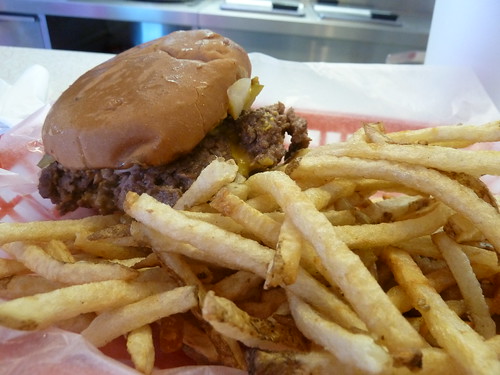
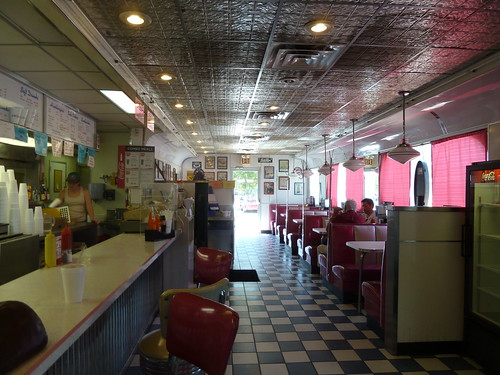
Presumably the oldest surviving hamburger chain in Wichita is the Kings-X chain; Jimmie King was an original White Castle franchisee in Wichita (where the chain started) and went out on his own some years later. Kings-X was always a slightly downmarket but good enough family restaurant chain with classic old school burgers with grilled onions. When a yuppie area on the east side took off, the younger generation built a new restaurant called Jimmie’s Diner which successfully managed to draw yuppies for, again, a real diner’s imitation of an imitation diner.
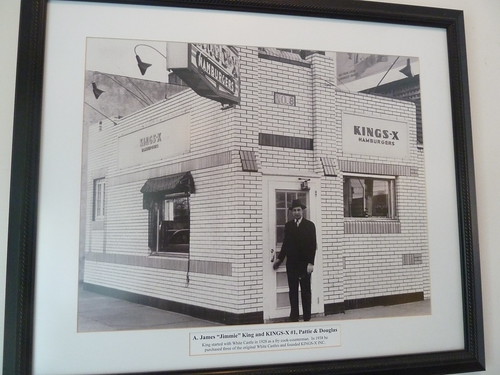
We stopped there for lunch after a matinee of Captain America. The burger was not up to Walt’s, though still better than 98% of Chicago family restaurant burgers, I’m sure. The odd thing about it, though, was that it tasted exactly like a Five Guys burger. Did Kings-X burger’s always taste like that, even before Five Guys existed, or are they imitating that chain (which has reached Wichita) instead of their own heritage? I don’t know, but it was strange.

Another old chain, food’s decent enough but I always loved the logo. I grabbed an excellent cherry limeade here.
My last burger stop was on the near West side, in what you might call the hippie-biker-artist part of town. T.J.’s had come highly recommended over the years, and it did not disappoint. The patty is bigger than a canonical 30s style thin patty, but I was impressed that they nevertheless managed to get a Schoop’s-like outer crust on it without murdering the inside. I ordered a chili burger just to have something different, and the chili was old-school beanless with some nice heat, again bridging tradition with modernity.
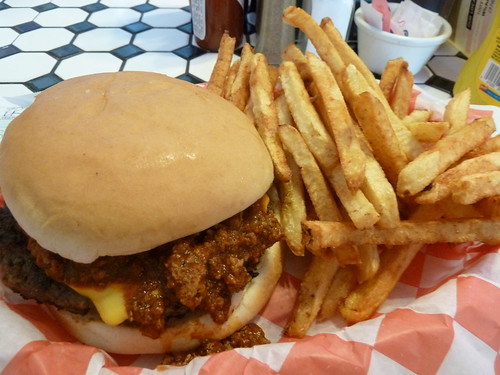
To be honest, though, I have to admit by this time I was pretty worn out by burgers, fries, black and white checkerboard tile, jukeboxes, pictures of James Dean and Marilyn Monroe sitting at the counter, etc. One thing I noticed driving around town this year was that there are lots of new barbecue places. Two Brothers is the one we tried (my in-laws ordered takeout one night) and it’s perfectly solid Kansas City-style BBQ, but I wonder about all these other places. Maybe next time that will be my quest– to see if Wichita can finally compete with Kansas City as a BBQ destination, too.
* * *
More interesting to me this time, though, was that Asian food has exploded in Wichita. Much of it, admittedly, is pure fakery, like a bunch of new Mongolian barbecue places. But a Chowhound thread pointed me to a place that was supposed to be a Thai-Lao Cafe— like the Malaysian restaurant I ate in last year, something we can’t get in Chicago. And like that Malaysian restaurant, located in a former pancake house where my sisters used to waitress, the Lao restaurant was located in a pretty ironically nostalgic location, a one-time Davy Crockett-themed arcade on the south side:

We went inside and the atmosphere was something between a VFW hall and the place the GI’s would have gone for R&R in Full Metal Jacket, a sort of tropical disco feel with the Lao extended family hanging out watching Dancing With the Stars or something at a long table littered with beer cans:

The menu looked straight Thai to me and I had to work my way through the entire family in search of Lao dishes. The son called Mom over, Mom barely spoke English and seemed unsympathetic to my desires, Dad finally came over and was much more amiable about helping me pick out things that he claimed were at least a little more like Lao dishes, though he said they didn’t have many of the Lao ingredients on hand. When we had made a decent list, he reached under the counter, and came back up with a dusty 1980s cash register, which he plugged into the plug next to the coffee maker to ring me up. Not a lot of food traffic, I thought, which made his greeting query (“You call for pickup?” even more curious. But no more curious than a (painfully) white family, 9-year-old son included, sitting there at the Phnom Penh disco waiting for takeout must have seemed to the occasional Thai or Lao person wandering in; pretty sure they’re not getting a lot of traffic from the east side of Wichita. It was pretty good authentic Thai, in the ballpark of our best places here, but if there was anything Lao about it, I wouldn’t know.
* * *

But I said we hung out with eagles. My sister-in-law found this privately run bird sanctuary west of town; with 100 degree weather the guy didn’t want to exercise the birds during the day, but he said if we came out early in the morning, he’d give us the tour. So we saw and interacted with hawks, kites, falcons, and…

He says he has the only bald eagle tame enough that you can pose for pictures with it. I’m always awestruck when I see a bald eagle in the flesh; it’s like seeing a president in person.
* * *

My old LTHForum colleague Aaron Deacon suggested Brobeck’s as another possible Kansas City BBQ destination, and being located right off 435 on our way to Iowa and Chicago, we decided to give it a try, even if it was white suburban barbecue in a strip mall.
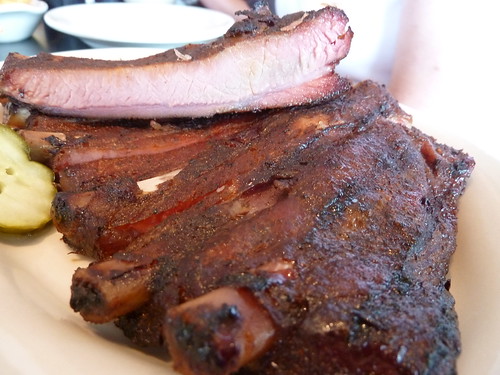
It’s really good white suburban strip mall barbecue, though— like Smoque, getting about the most you can out of a Southern Pride. Burnt ends were terrific, ribs and smoked sausage quite good, and the sample of ham salad offered at the start worth a lunch trip (well, not from Chicago maybe, but from the KC area, sure). One thing that amused me: besides their own sauces, they offered dispensers of other popular sauce brands like K.C. Masterpiece and Gates’. To me that’s Coke offering you a shot of Pepsi to put in your Coke, but I guess these sauces have such a following that it makes sense in Kansas City.
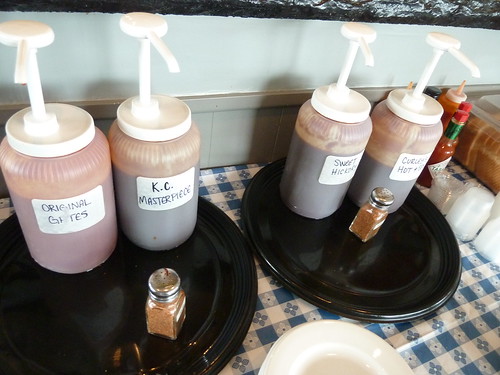
Noticeably missing, though: Arthur Bryant’s.
Finally, we stopped over in Iowa City. Being a college town, Iowa City’s culinary scene seems dominated by pizza, and the Yelp reviews for any of them are not spectacularly good, but the best of the bunch seemed to be an old place called Pagliai’s.

Last year we ate pizza in the Quad Cities area; this, though another hour further from Chicago, seemed much closer to a Chicago pizza, the same rolled-out crust you see around town, a thin tomatoey sauce like D’Agostino’s, and where the Quad Cities pizza’s idea of sausage was crumbly breakfast sausage-style, as it is through much of the midwest, this had nice lumps of pretty good Italian sausage. A very decent pizza— and at least it wasn’t another damn hamburger.
Tags: bbq, burgers, iowa city, kansas city, pizza, wichita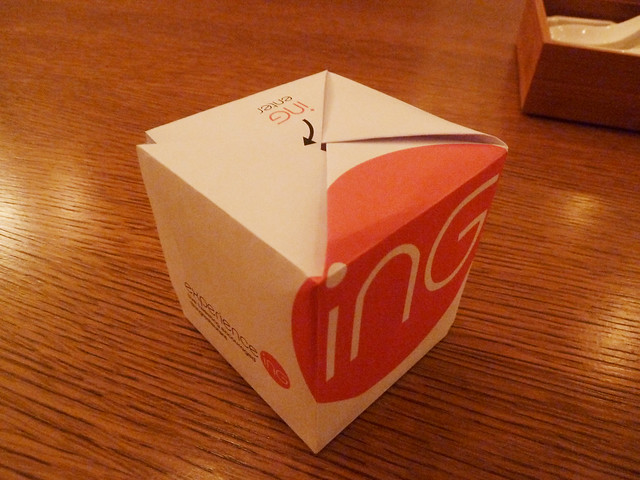
If the Miracle Berry didn’t exist, Homaro Cantu would have had to invent it.
Cantu has long been seeking something beyond mere food, a kind of altered-reality experience where he could be the Timothy Leary opening new doors of perception. The problem is that dinner is, in the end, dinner, not a higher consciousness, and his claims of changing the world with food wind up overselling, and thus diminishing, the experience of his often genuinely clever and witty food. Cantu is working in the genre of other food-magicians descended from El Bulli, perhaps closest to Heston Blumenthal who takes a particular magician’s delight in misdirection, making a dish that looks like one thing but turns out to be another. But Blumenthal is David Copperfield, staging elaborate tricks to make you laugh with delight, while Cantu seems to want to be Uri Geller, trying to make you believe it actually happened, right there on Mike Douglas.
Which is why the Miracle Berry is such a natural for him. For once, the trick genuinely doesn’t happen on the plate, but in your mind. Dropping a Miracle Berry tablet— the experience can’t avoid LSD connotations, and at iNG, shows no signs of wanting to— produces an effect by which sour things are perceived as sweet. It’s less pronounced than advertised, perhaps, but it’s there— you’re given slices of lemon and lime on which to test your tongue once you’ve dissolved the tablet, and lemon goes from lemon to tart lemonade, basically.
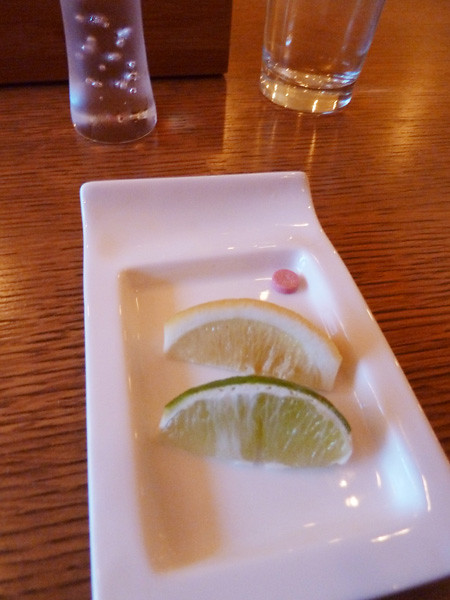
The problem is that having once taken the tablet, you’re stuck on the other side of the door— any dish or cocktail you’re given will taste like its Miracle Berry-ized self, without necessarily a frame of reference for the original dish. The Miracle Berry “Flavor-Tripping” menu at iNG confronts this problem with varying degrees of success.
I never ate at Otom, so I don’t know how much iNG resembles its predecessor in the space, though what its go-go boots-white and red interior did remind me of was Mod, the long-ago restaurant where The Violet Hour is now. The amuse which arrives inside your folded paper box of a menu seems to be there just to match the room, but what comes next is well designed to show the effect: a cocktail which tastes (somewhat) like a margarita before you suck the berry, and (somewhat) like a tequila sunrise after. It makes the point, though perhaps out of a desire to show up The Aviary a couple of doors down, it tries too hard. Some of The Aviary’s cocktails are meant to change flavor as they steep in their ingredients, like tea— a naturalistic, and probably pretty subtle, effect. iNG not only short-circuits the process with the Miracle Berry but with a small tube of cherry juice, which spills into the drink as you lift it to drink. By the last sips cherry flavor has sledgehammered the subtler Miracle Berry effect; less would have made more of the effect.
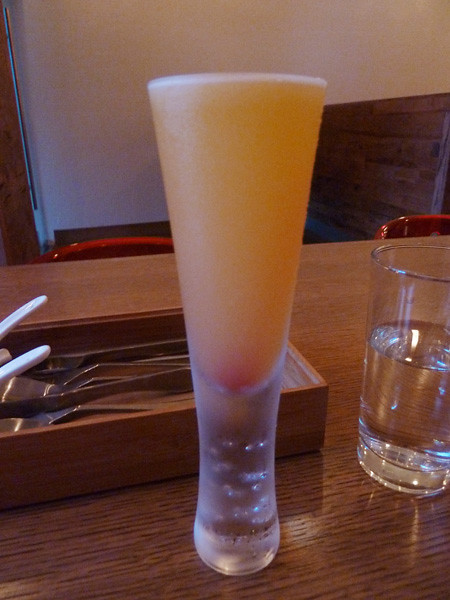
The first real food course, a sort of deconstructed Beausoleil oyster covered in uni and frozen-grated foie gras, doesn’t seem to draw on the Miracle Berry effect, but its drink pairing is quite wonderful: a taste of Dogfish India brown ale, in which the sweetness of a brown ale surges to the front under the berry’s effects. In this case the extra twist is well chosen: it’s served in a smoked glass, a neatly economical version of Blumenthalesque scent dishes involving things like smoking hay on your plate.
I got two of iNG’s baozi, meltingly tender pork buns, so I would have loved to have tried one before and one after the Miracle Berry. Not that it would likely have made much difference; these are so tasty that you almost want to tell Cantu to forget the fine dining stuff and just get a baozi truck out on the streets as fast as possible.
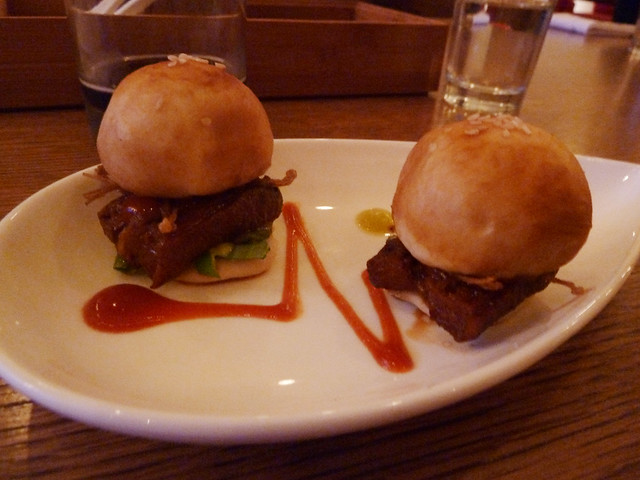
The next dish, a version of Nobu’s miso-black cod dish (I swear, Nobu by this point is the Colonel Sanders of black cod), seems a less wise choice for the Miracle Berry— already on the sweetish side, it becomes downright candy-coated under the Berry’s influence. (I’d rather have had a puttanesca sauce or something equally savory to serve as the Berry’s foil by this point.) While a duck dish with mint and white chocolate in its sauce (not so I could tell) was a very pretty plate, but what the Miracle Berry contributed to it (and by this point I’d been given a refresher Berry) wasn’t clear to me.
Far more impressive was its effect on the drink pairings with these dishes— a slightly fruit-forward pinot noir was like sipping a fine balsamic vinegar, while a dry Riesling came off for all the world like an ice wine. Dessert followed— but as it’s a charming visual joke, I won’t spoil it.
So did I see an altered reality, or a possible future food? I doubt it, though the Miracle Berry’s use as a sugar substitute that works on the mind rather than the food is certainly intriguing, albeit more from a food-business standpoint than a culinary one. I look at the meal more prosaically: as a triumph of showmanship. The fact is this meal, minus the Miracle Berry, is nothing strikingly unusual— all very nicely done in an Asian-minimalist way, subtle and a little sedate for my tastes, one you can imagine having any number of places (especially the black cod). The Miracle Berry and the whole presentation around it turns a pleasant meal into a mindbender in which you think hard about every course, tasting and testing and waiting for transcendence. If it never arrives, you’ve still made more out of this meal than it would have on its own in a more conventional restaurant. As I said before, Cantu has found a magic trick that takes place not on the plate, but in your head.
Tags: Homaro Cantu, iNG, Miracle BerryIn the new Key Ingredient, Jeff Hedin at Leopold uses one of the few parts of the rabbit he wasn’t already using— the lungs. Read it here.
Of course, I had already shot video of Hedin here:

Click “Our Season of Pig” under Categories at right to read past installments.
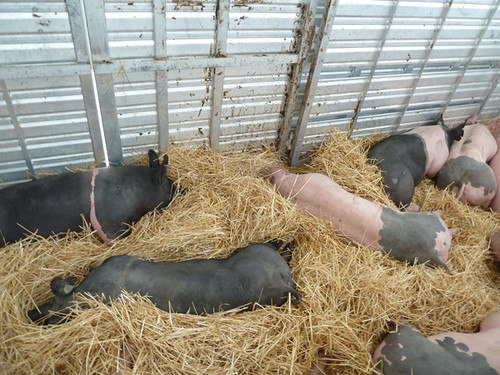
The truck pulled into the gravel lot and slowly backed up to the swine barn. We held plastic barriers between the truck and the walkway to the pens, and the doors opened:
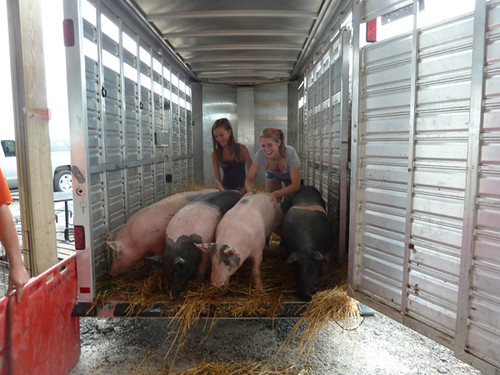
The pigs didn’t want to take that first step out of the truck, but by slapping their hams and pushing them (100-lb. girl putting all her might against 250-lb. pig), they were eventually all unloaded:
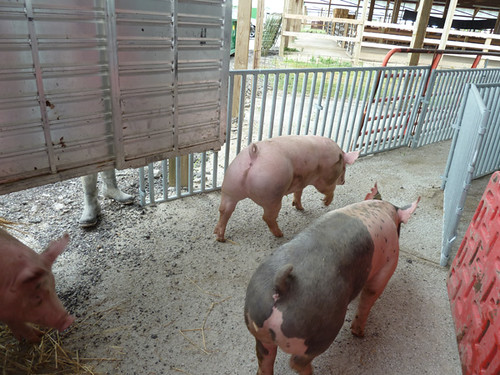
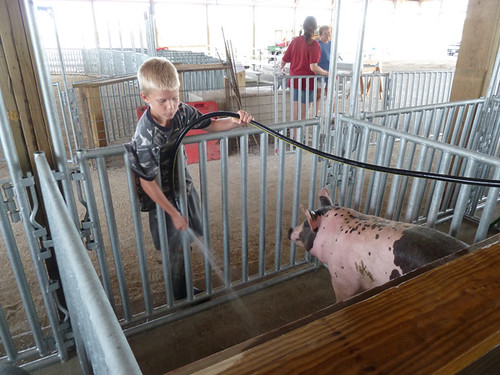
We washed them, a somewhat quixotic effort since pigs have a habit of fouling themselves just as you get them clean. The big unspoken joke of all this is that you’re competing for an award for showmanship when your animal’s idea of on-stage behavior is blithely pooping a continuous stream the whole time you’re smiling at the crowd and they’re applauding. You can see why pig-raising countries like Spain invented Dada and Surrealism.
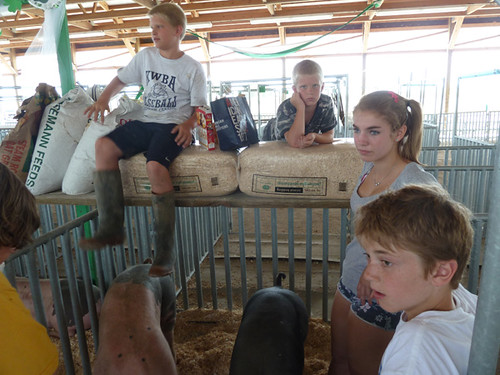
But we got them clean enough, and set them up in their pens, decorated with pictures and ribbons. Then the kids began feeding some of them high-fat foods like cake mix to get their weight up for the official weighing-in the next day, while others (who were too close to the top of the weight class) watched and squealed angrily at being deprived.
* * *
Wednesday there were two shows— one was to judge the pigs, one to judge showmanship. Frankly, I have no idea what the distinction is with pigs; in both cases, the pigs just run where they want, and the kids chase after. (With lambs, there was at least some degree of walking them like a dog.) This was the judging among the 4H clubs; then there’s the open show judging on subsequent days. Lots of chances to get ribbons is the point, I guess.
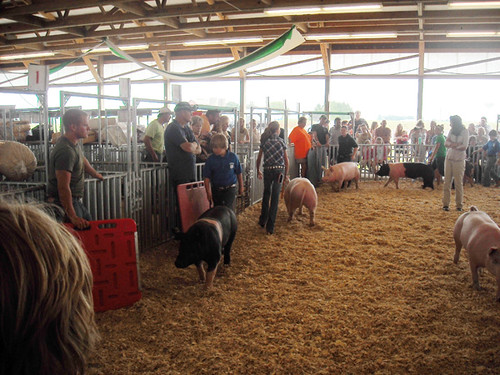
The same judge, surprisingly not a gravel-voiced old rancher but a serious young woman, judged both. She judged six different weight classes, picking a champion and reserve champions in each, justifying her choices with language that combined cool matter-of-factness about these animals being product with a kind of aspirational language that sounded like we were trying to help them get into good schools. Her favorite words seemed to be “practical” and “everyday,” as if pigs were hairdos or sensible pants.
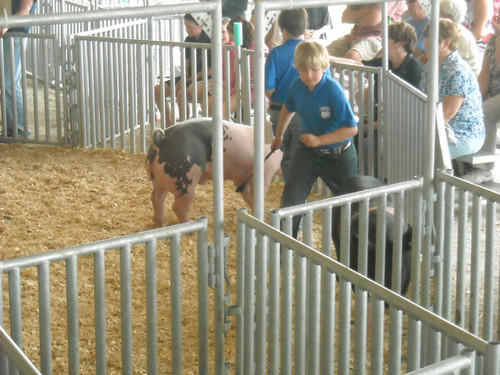
Liam guides Thor around the ring.

After a couple of weight classes we noticed a definite pattern— our club’s pigs usually seemed to come in dead last. I asked Julie, our club leader, why that was. She said part of it was due to our not keeping their weight up during the day of transportation and arrival; they didn’t eat due to stress and heat, and many of them lost weight rapidly. But the other part, she said, was that most of the others had probably fed their pigs Paylean, a supplement commonly used for show animals that’s basically steroids for pigs. It gives them good muscle development for the show, but the price is that it turns the meat mushy— and if you’ve eaten pork that struck you as soft and spongy, a supplement like Paylean is probably part of the reason. This is when I’m glad that, for all that we work hard and want to do well, it kind of doesn’t really matter so seriously in our lives that we’re tempted to use modern industrial-farming practices like this. If we come in last for following some principles about raising the pigs a little more naturally, that’s not so bad.
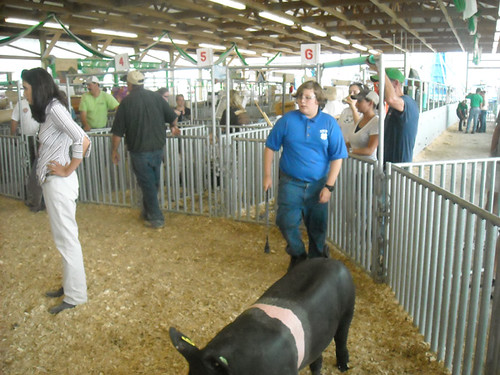
Showmanship followed and the judge hardly even seemed to look at our pigs, or our kids; we knew we didn’t meet her industrial pigs-as-product standards, and again we came in low in the group. But the kids didn’t seem to mind; it’s more about the fun of being together at the fair than it is about winning.
* * *
Friday night was the real excitement— Battle of the Barns, between the kids from all the different 4H groups. It started with a relay race including such athletic activities as running with a greased watermelon…

and running backwards around the cows.

Then the tug of war in the mud…

The adults wisely backed up once it was over, because:





When it’s over, the kids hose themselves off as best they can in the same place where they washed their pigs a few days before. Watching some of the teenagers horse around in the water, many of the older girls finding excuses to get down to bathing suits they had conveniently placed under their Battle of the Barns clothes, I couldn’t help but think that as a way to make farming cool among today’s teens, 4H is way underselling this whole coed-mud-showering thing…

* * *
Saturday was the auction. Unlike with the lambs in past years, with pigs again you just kind of chase yours around the arena.
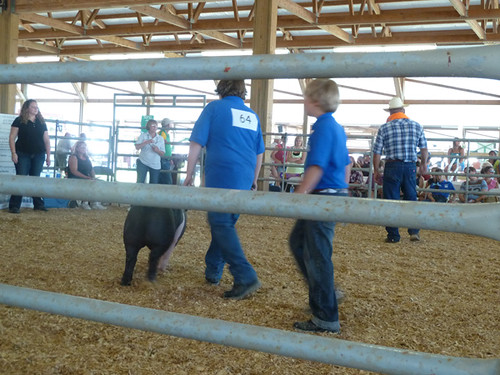
Pigs were last (after cattle, goats and lambs) so we had plenty of time to observe, happily, that prices were up again after being pretty low last year. Where cattle prices were in the dollar and something range last year, this year it was more like three dollars and something. Part of this might be that buyers are less spooked by the economy than they were last year, but part of it was also that the various clubs and the fair were making a more serious effort to cultivate buyers— there was a nice little reception at the back of the swine barn this year, complete with beer, for prospective bidders. In the end, though, our pig was sold to the same man who bought two of our lambs (and donated them to a local food bank) in past years, and we got a good price, $3.25 a pound, which means we turned a modest profit on our kids’ activity. Add in the gold star that Liam got on one of his art projects— meaning he made the short list for Grand Champion in that category— and we had a good year.
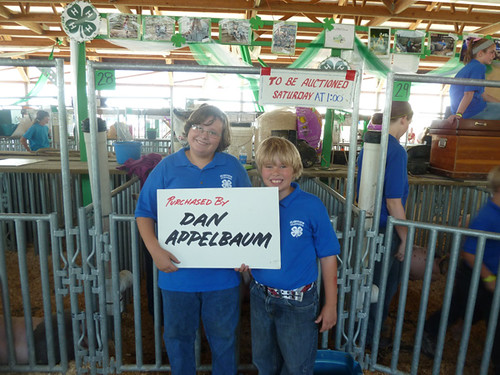
Although Myles made some comments about not shopping anywhere that bought our pigs for at least a year, in the end they weren’t bothered by a season of raising one of their favorite foods. Although pigs are more intelligent and were certainly easier to handle than lambs, they’re still kind of alien, and the kids didn’t bond with these ominously large, black-eyed (except for Frank) creatures as they might a dog. Myles even ate pulled pork at the carnival just a few hundred yards from his own pig. I don’t think this is bad in any way; only city dwellers can sentimentalize all animals as comparable to household pets. Farming has a vastly different view of livestock, and the symbiotic relationship of humans and domesticated animals is a natural thing which developed over millennia and needs to be reintegrated into our modern lives, not shunned or denied. I’m glad my kids have had a chance to discover it and understand it for themselves— including, recently, visiting a slaughterhouse and processing plant (though not observing slaughter, but engaging with it directly) for a future Sky Full of Bacon podcast. I feel I have done everything I can to prevent them from growing up to be food hypocrites, at least.
Along the way Myles said something to me which, as he sometimes does, showed a surprisingly adult perspective on his own childhood. As the summer went along and the demands of having a 4H pig got more intensive, he occasionally whined about the time it was taking up in his summer versus some imagined glorious summer of socializing as a preteen. (In reality, given that time he’d have read Harry Potter over again with his iPod in his ears.) But as Fair week approached its end, he said, “I know I’m going to complain about it sometimes, but I want to do a pig again in 4H next year. I like being part of something bigger.”
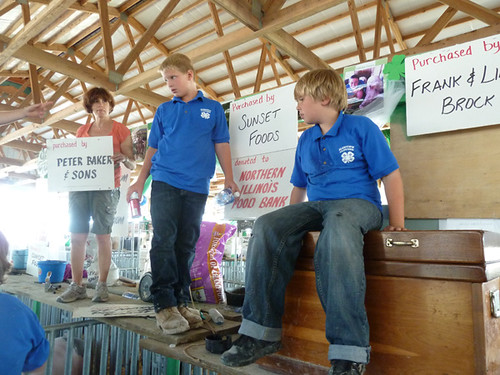
Special thanks and well wishes to our adviser, Julie Tracy, whose guidance and support during a difficult personal time is appreciated and treasured by all of us in the Glenview Clovers 4H club.
This week’s Key Ingredient is one of the most fun visually, just because the ingredient is… so damn big. But you don’t have to smell it, at least.
Read it here.
And thanks to Nick at Grub Street for the shout-out for my Perennial Virant review (in contrast to Pat Bruno’s, which appeared right after– Kevin Boehm told us Bruno had just been in).
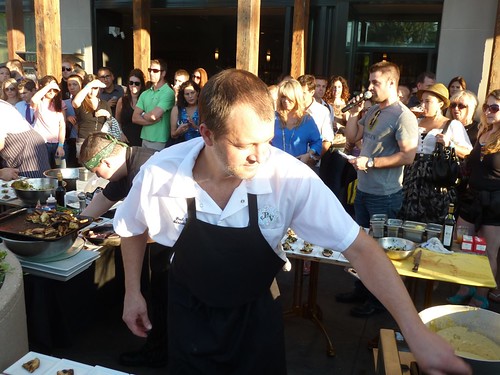
Paul Virant during the quickfire challenge between Chris Pandel and himself at Perennial Virant, July 25. I posted a slideshow and recap at Grub Street Chicago.
Next is fascinating, perfectionist, imaginative and eye-opening— and, ultimately, a kind of cul-de-sac; nobody really thinks that Parisian dining from 1906 will spread nationwide. It’s a fantasy dining experience with a necessarily short life. But because Next and Grant Achatz are daring and endlessly fascinating, the restaurants that represent where dining is really going right now are pushed out of the limelight, half overlooked even in the best of cases. Paul Virant opening a restaurant on the doorstep of the Green City Market, returning to the city to do battle with the best chefs in town after years singlehandedly putting some place called Western Springs on the map, could have been one of the great stories of the year. Instead it’s— oh what, Paul Virant’s cooking fresh vegetables and artisanal meats? That’s nice. Have to check that out some— HOLY CRAP NEXT JUST RELEASED TWELVE MORE TABLES ON FACEBOOK!
I feel almost alone in my belief that the most exciting news about a name chef opening a new place in 2011 has always been Perennial Virant. As much as that other food may dazzle in its ingenuity, represent the pinnacle of a kind of competitive perfectionism, the food that speaks to my soul is the food that makes comparatively simple use of the best ingredients. As I wrote reviewing Vie a couple of years ago, “in my experience there’s no Chicago restaurant at work right now better than the meal I had last Saturday night, for its dedication to getting the best, richest, most purely satisfying flavor out of the best ingredients. And if you can think of other things a restaurant should be doing first, well, we just have different priorities, I guess.” I often feel there’s a disparity in what I want from fine dining and low end food— fine dining is intellectual, sometimes to the point of seeming bloodless, low end food makes your soul sing. Vie does a better job than anywhere of bridging that gap— not just applying haute skills to homey dishes, but using homey products, all that stuff he pickles and preserves and cures, in a way that has the complexity and sophistication of haute cuisine. I love fine dining, and I love barbecue and diner food and stuff like that, but best of all… I love not having to choose between their respective pleasures in the same meal.
Yet the first reports I heard on Perennial Virant, from people I give all due respect to, were not all that good. So I didn’t rush to try it immediately, hoping that a little time would help it find its footing. I went earlier this week for a PR event, a cookoff between Virant and Chris Pandel of The Bristol (who is also, like Virant, being pulled into the orbit of the Boka Group). While there I ran into LTHer Crazy C and her husband, and wound up joining them for dinner. Charlotte (that’s what the C is for) was back for the third or fourth time since the restaurant opened, and she had no doubts about the caliber of what Virant is doing here— even as she was dismayed by that day’s news of the departure of Boka Group pastry chef Kady Yon for the Public Hotel, home to The Pump Room.
The menu, maddeningly, is divided into small, medium and large, though it was hard to see, either in price or the actual dishes, any particular difference between medium or large. We didn’t worry about it and instead focused on what we knew were Virant’s strengths. A silky pork pate had its fattiness precision-cut by the sweetness of Virant’s housemade strawberry jam. Something called Ted’s Cornmeal Cake— Ted’s Cornmeal is apparently sold by Three Sisters at the Green City Market— combined crumbly cornmeal and gooey burrata into a dish that seemed like decadence on a farm in Iowa. A robustly smokey lamb andouille sausage was combined with small shrimp and cabbage cooked in a complexly flavorful broth. Gnocchi were too soft, almost mashed-potatoey for me, but a dish of smoked short ribs with pickled onions and spaetzle was terrific, like if barbecue had a baby by a German soldier.
Before dinner I told Kevin Boehm that one of the things I liked about GT Fish & Oyster was that it was priced, and had an atmosphere, where everything didn’t have to be perfect to make you happy. I’m not sure any restaurateur ever quite hears something like that as a compliment, but when everyone’s raving about a restaurant where you have to slam the computer keys to get in at all, and price and expectations are high enough that anything below perfection will disappoint, something about the relaxation of fine dining has gone out the window. And what I liked about GT is also one of the things I liked about Perennial Virant— I felt I could come back here next week, have a bunch of new things, and be just as happy with what I had that night. There’s no pressure on me as a diner to love it or else; the love for great ingredients at Perennial Virant is generous, unconditional love.
Disclosure: I was a media guest at the Quickfire, and chatted with both Virant and Kevin Boehm at different points in the evening, but paid for my entire dinner.
This week’s chef is Nick Lacasse at the Drawing Room; the ingredient is whelks, the article is here. Fun fact: as I was waiting for Julia for the shoot, a bunch of big black cars drove up and Mayor Emanuel emerged to go to lunch next door at Le Colonial. An odd time to be standing there with a tripod and a camera, but no particular interest in filming the Mayor…
Meanwhile, nothing here last week other than pig beauty shots because I was doing Grub Street Chicago. Here’s a link to the five days I did it, for posterity: M T W Th F
More practically, here are links to a few of the most interesting pieces:
Mark and Liz Mendez Talk Food at Their Wine Bar, Uva
Do Not Underestimate the Power of Next
Clandestino, Author Plan Vincent Price-Inspired Dinners
Blackboard Eats Launches Chicago Edition Under Editor Louisa Chu
Slideshow from Green City Market BBQ
Big Jones Fills Stomachs The Old-Fashioned Cajun Way


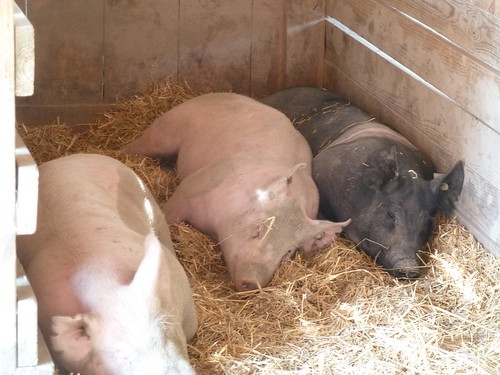
As noted, I’m up to my eyeballs doing Grub Street Chicago this week, but at least I can put up some photos of the pigs from the last month and a half before we go to the Lake County Fair next week. There hasn’t been that much that was all that different. We had a “Show Your Animal Night” to encourage bidders at the fair, so we had to groom them, which including shampooing the pigs, cutting the cows’ hair, and cleaning the lambs and keeping them clean in their psychedelic lamb tubes:

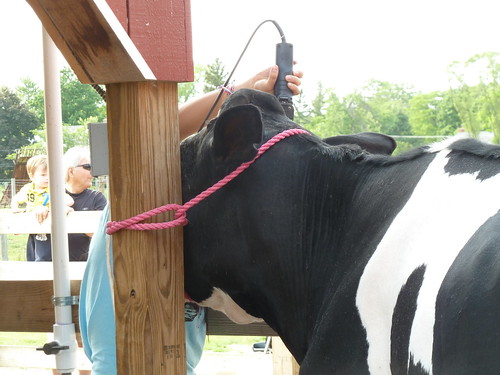
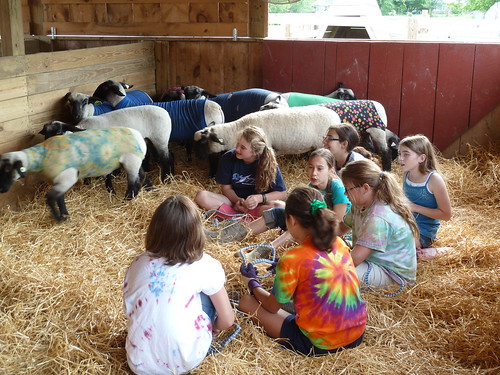

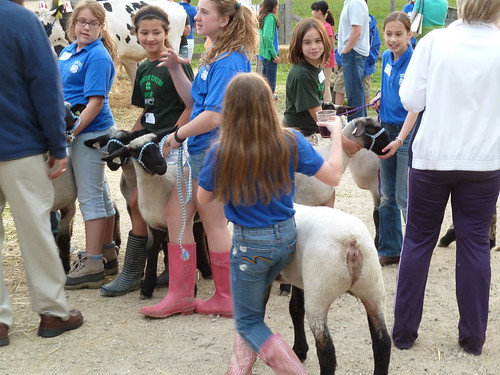

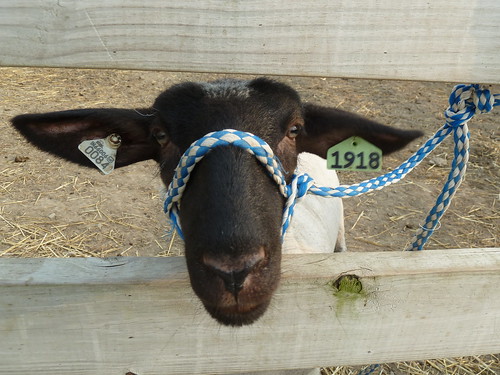
* * *
After that, it’s just been regular rounds of feeding the pigs and cleaning the pens…
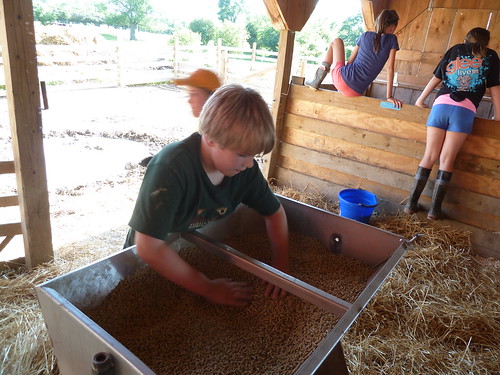
and exercising them by leading them out of their pen into a fenced field nearby. We use our Temple Grandin training to give the pigs pretty much only one choice of where to go, and once the first pig goes, the rest are curious enough to follow and run free.
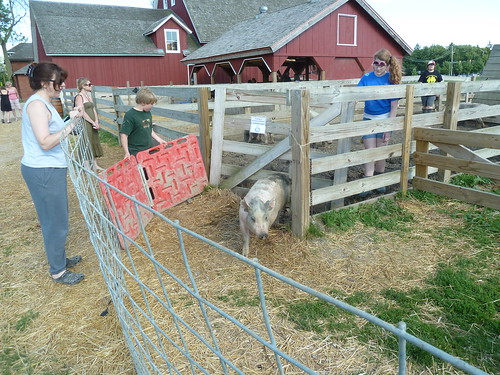
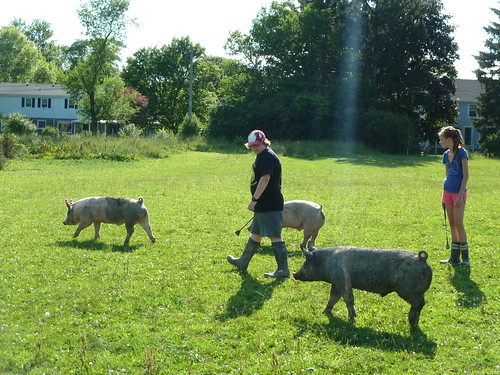
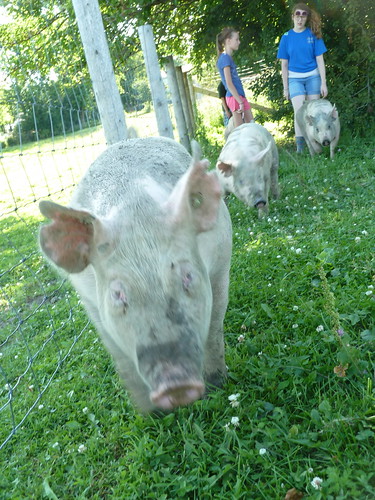
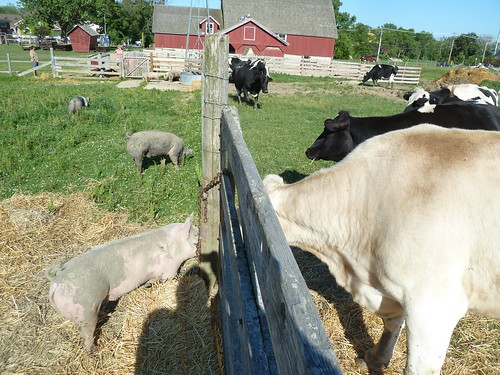
After exercise, time to cool down:
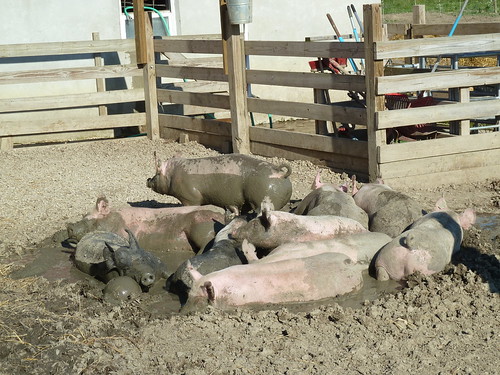
On a hot day, they love the hose.
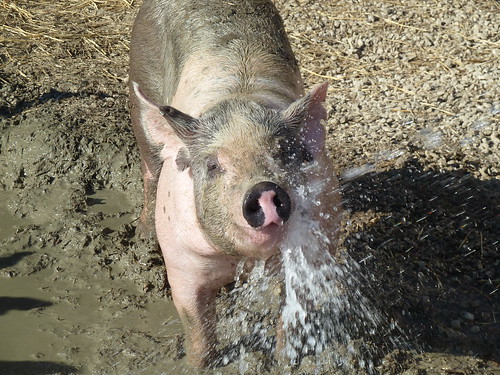
* * *
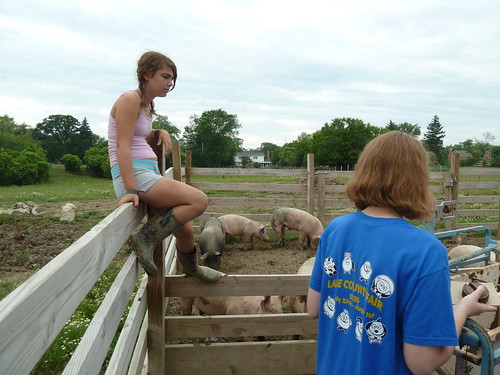
Feeding has gotten increasingly complicated. We have milk for some pigs to help them grow faster, and we sequester other pigs to keep them from eating it all. You have to nail weight within a certain range— it would be too easy to simply stuff a pig sick to sell him for more at the per-pound price— so we get increasingly anxious as the fair approaches, is our pig too fat, too lean, will he make his weight. The near-daily emails adjusting the regimen all sound like this:
Everyone is looking good, NEW FEEDING INSTRUCTIONS ARE ON THE BOARD
1. Heavy weights are going back on show feed at a higher rate- no oats this week
2 Feed a bag of show pig feed to the big pen , mix with about 4 cups of oil
3. SEPARATE RUDY AND SNOOPY- THEY GET ALL THE MILK, THEN LET THEM OUT. THEY ARE MARKED WITH A GREEN STRIPE ON THEIR BACKS
4. Snoopy, Gip and Phin are getting overdrive this week- this will be hand fed to them so lets make sure it gets done and not done more than once a day for snoop and twice a day for gip and phin- we need to communicate with each other.
Here’s last Saturday’s weigh-in:
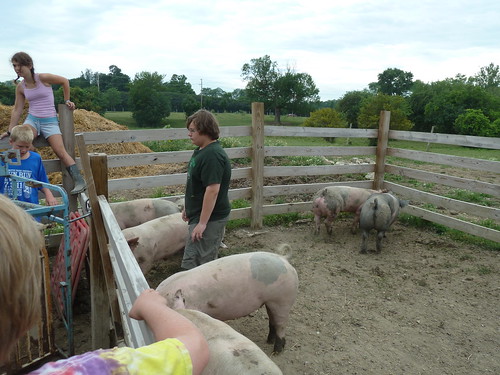


Right on target!


Myles and Liam with Thor, 247 pounds:
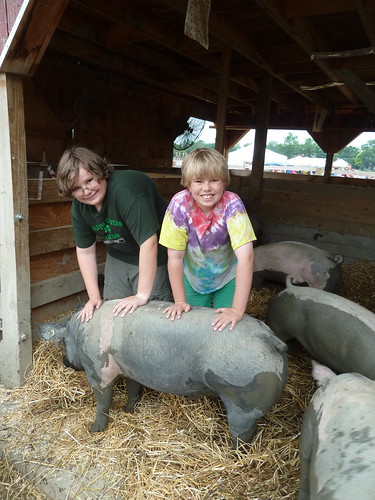
The beer issue of the Reader evidently got so big that it squeezed out this week’s Key Ingredient with Nick Lacasse at the Drawing Room; watch for it next week. In the meantime, I’ll be subbing for another Nick (Kindelsperger) at Grub Street Chicago, so look for me there starting Monday and through the end of the week.
Wouldn’t want you to be without video, though, so here’s a promotional video I made for Heather Shouse and her food truck book at the Goose Island “food truck summit” in April:
And enjoy these outtakes from the Michael Carlson shoot.

 Posted in
Posted in 




